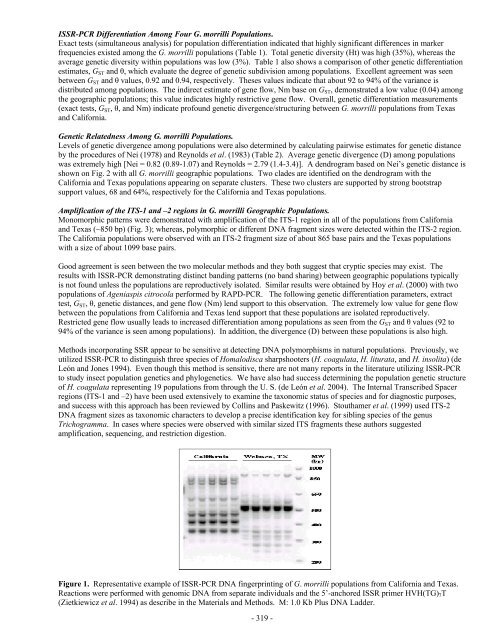Impact Of Host Plant Xylem Fluid On Xylella Fastidiosa Multiplication ...
Impact Of Host Plant Xylem Fluid On Xylella Fastidiosa Multiplication ...
Impact Of Host Plant Xylem Fluid On Xylella Fastidiosa Multiplication ...
You also want an ePaper? Increase the reach of your titles
YUMPU automatically turns print PDFs into web optimized ePapers that Google loves.
ISSR-PCR Differentiation Among Four G. morrilli Populations.<br />
Exact tests (simultaneous analysis) for population differentiation indicated that highly significant differences in marker<br />
frequencies existed among the G. morrilli populations (Table 1). Total genetic diversity (Ht) was high (35%), whereas the<br />
average genetic diversity within populations was low (3%). Table 1 also shows a comparison of other genetic differentiation<br />
estimates, G ST and θ, which evaluate the degree of genetic subdivision among populations. Excellent agreement was seen<br />
between G ST and θ values, 0.92 and 0.94, respectively. Theses values indicate that about 92 to 94% of the variance is<br />
distributed among populations. The indirect estimate of gene flow, Nm base on G ST , demonstrated a low value (0.04) among<br />
the geographic populations; this value indicates highly restrictive gene flow. Overall, genetic differentiation measurements<br />
(exact tests, G ST , θ, and Nm) indicate profound genetic divergence/structuring between G. morrilli populations from Texas<br />
and California.<br />
Genetic Relatedness Among G. morrilli Populations.<br />
Levels of genetic divergence among populations were also determined by calculating pairwise estimates for genetic distance<br />
by the procedures of Nei (1978) and Reynolds et al. (1983) (Table 2). Average genetic divergence (D) among populations<br />
was extremely high [Nei = 0.82 (0.89-1.07) and Reynolds = 2.79 (1.4-3.4)]. A dendrogram based on Nei’s genetic distance is<br />
shown on Fig. 2 with all G. morrilli geographic populations. Two clades are identified on the dendrogram with the<br />
California and Texas populations appearing on separate clusters. These two clusters are supported by strong bootstrap<br />
support values, 68 and 64%, respectively for the California and Texas populations.<br />
Amplification of the ITS-1 and –2 regions in G. morrilli Geographic Populations.<br />
Monomorphic patterns were demonstrated with amplification of the ITS-1 region in all of the populations from California<br />
and Texas (~850 bp) (Fig. 3); whereas, polymorphic or different DNA fragment sizes were detected within the ITS-2 region.<br />
The California populations were observed with an ITS-2 fragment size of about 865 base pairs and the Texas populations<br />
with a size of about 1099 base pairs.<br />
Good agreement is seen between the two molecular methods and they both suggest that cryptic species may exist. The<br />
results with ISSR-PCR demonstrating distinct banding patterns (no band sharing) between geographic populations typically<br />
is not found unless the populations are reproductively isolated. Similar results were obtained by Hoy et al. (2000) with two<br />
populations of Ageniaspis citrocola performed by RAPD-PCR. The following genetic differentiation parameters, extract<br />
test, G ST , θ, genetic distances, and gene flow (Nm) lend support to this observation. The extremely low value for gene flow<br />
between the populations from California and Texas lend support that these populations are isolated reproductively.<br />
Restricted gene flow usually leads to increased differentiation among populations as seen from the G ST and θ values (92 to<br />
94% of the variance is seen among populations). In addition, the divergence (D) between these populations is also high.<br />
Methods incorporating SSR appear to be sensitive at detecting DNA polymorphisms in natural populations. Previously, we<br />
utilized ISSR-PCR to distinguish three species of Homalodisca sharpshooters (H. coagulata, H. liturata, and H. insolita) (de<br />
León and Jones 1994). Even though this method is sensitive, there are not many reports in the literature utilizing ISSR-PCR<br />
to study insect population genetics and phylogenetics. We have also had success determining the population genetic structure<br />
of H. coagulata representing 19 populations from through the U. S. (de León et al. 2004). The Internal Transcribed Spacer<br />
regions (ITS-1 and –2) have been used extensively to examine the taxonomic status of species and for diagnostic purposes,<br />
and success with this approach has been reviewed by Collins and Paskewitz (1996). Stouthamer et al. (1999) used ITS-2<br />
DNA fragment sizes as taxonomic characters to develop a precise identification key for sibling species of the genus<br />
Trichogramma. In cases where species were observed with similar sized ITS fragments these authors suggested<br />
amplification, sequencing, and restriction digestion.<br />
Figure 1. Representative example of ISSR-PCR DNA fingerprinting of G. morrilli populations from California and Texas.<br />
Reactions were performed with genomic DNA from separate individuals and the 5’-anchored ISSR primer HVH(TG) 7 T<br />
(Zietkiewicz et al. 1994) as describe in the Materials and Methods. M: 1.0 Kb Plus DNA Ladder.<br />
- 319 -











